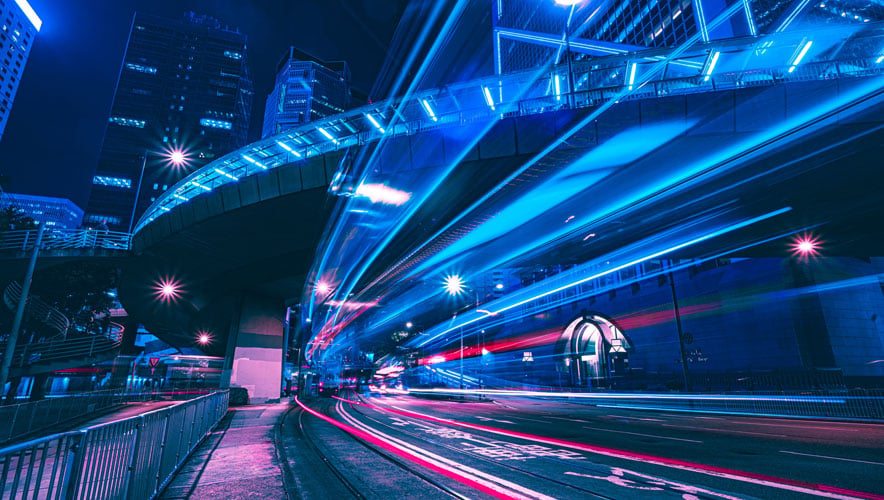Driving the Smart City Revolution with AI-Enabled Analytics
The term “smart city” has gone from a buzzword to a reality in recent years. Now, we are at the point where we have both seen this concept in action long enough to know its benefits and know the potential of what is to come. Cities and municipalities are leveraging artificial intelligence-enabled analytics to produce deeper insights to promote safety and efficiency.
 Smart buildings are essential building blocks within the complex smart city ecosystem as they contribute significantly to the sustainability of cities. Many governments’ visions of smart cities include not only making urban environments more sustainable, but also safer and more convenient for residents. Smart video technology in tandem with video surveillance is helping make cities and public buildings smarter, as well as safer. Both government authorities and private enterprises are benefiting from the latest technology trends and deploying smart video technology in a sustainable way.
Smart buildings are essential building blocks within the complex smart city ecosystem as they contribute significantly to the sustainability of cities. Many governments’ visions of smart cities include not only making urban environments more sustainable, but also safer and more convenient for residents. Smart video technology in tandem with video surveillance is helping make cities and public buildings smarter, as well as safer. Both government authorities and private enterprises are benefiting from the latest technology trends and deploying smart video technology in a sustainable way.
The Future of Public Transportation
Technology is already performing more critical tasks in public transportation to improve operations and safety, helping automate routines and make it more efficient. Artificial intelligence (AI) video analytics are playing a key role in this, as smart cameras can do much more than just record and deliver video footage.
Smart railways and metro surveillance are combining smart cameras and AI video analytics to help operators and transit planners systematically monitor and understand passengers’ behavior. This provides valuable insights from video data to optimize passenger flow and minimize security and safety risks in real time. This same technology is being applied to cities and public buildings to help authorities, operators, and planners to monitor and understand urban life, improving mobility and infrastructure for long-term planning.
Improving Smart Traffic and Parking
AI-enabled smart cameras have the potential to take security and traffic management in urban environments to the next level.
Traffic operators and planners worldwide are struggling with major challenges due to poor traffic planning based on little data. Millions of people waste valuable time every day in traffic jams and slow-moving traffic. Also, traffic in cities causes too many casualties, deaths, and injuries in crashes. Outdoor surveillance cameras equipped with AI video analytics help continuously monitor traffic and detect and eliminate both situational and structural issues.
AI video analytics are being implemented in a variety of ways to promote overall safety. These analytics detect pedestrians at crosswalks and align traffic signal controls with actual occupancy. They also detect and remove traffic obstacles by identifying anomalies such as objects and people on streets and let smart cameras take automated action. Real-time situational awareness is achieved by adapting traffic control to density by continuously analyzing vehicle volume and behavior to automate the control of traffic lights and digital speed limits. Future data-driven planning is improved by analysis of road layouts to gather valuable performance insights and vulnerabilities.
Smart parking management is helping make better use of existing parking spaces through video technology. Parking shortages in cities primarily occur when parking is poorly managed and inefficient, or if there are more cars on the road than available parking slots. In many cases, smart parking management does not require new systems to be installed but preferably existing ones to be empowered using AI applications to reduce wait-times and crowding both on-street and in parking garages by identifying occupancy and optimizing available space. By implementing this technology, smart cameras can leverage analytics to scan license plates and earlier identify which vehicles are permitted to a certain lot without installing an additional gate or barrier.
These analytics take existing camera technology a step further by not only identifying occupied and free spaces in parking lots but also triggering actions within traffic control systems. Even violations of protected parking areas are recognized and automatically reported. Access management is optimized by recognizing vehicles based on license plates or vehicle types. Overall, this produces insights through one surveillance camera system whereas multiple would have been required in the past.
Managing Smart Buildings
AI video technology is making buildings and public spaces smarter and more versatile by enabling automated crowd counting, occupancy monitoring, crossline detection, and heat mapping for crowds. This is accomplished by informing employees or controlling digital information systems to respond quickly to critical events. Video data can also be analyzed to improve operations and passenger services. Surveillance that required complex computer systems in the past is now executed directly on the devices (edge-computing).
Smart video technology detects the emergence of fire or smoke in buildings and outdoor areas and triggers alarms faster and more reliably than humans can. Fire is one of the foremost dangers for both the people and assets that populate these spaces. Therefore, the prevention or detection of flames and smoke is crucial.
Suspicious and violent behavior is also identified in large and complex buildings that offer more space for property damage and violence. Security personnel often struggle to manage all areas at all times. Smart video technology comes into play to enable cameras to not only deliver video, but also analyze it and trigger actions themselves. It does this by detecting normal activity patterns and triggering an alert when behavior occurs that deviates significantly from ordinary activities, such as a fight, a person falling or lying on the ground, loitering, or burglary. Additionally, access control can be monitored using facial recognition to restrict certain site areas.
Smart cameras also improve smart building management through customizing the building’s inner workings to the behavior of its occupants. Air conditioning can be adapted to room occupancy detected over a certain period of time, adjusting ventilation or heating according to demand. Ergonomics at the workplace may also be improved using AI to detect the size and stature of people, automatically adjusting the height of desks to suit individual needs. Even lighting can be optimized by analyzing lighting conditions for weather and structural characteristics to adjust brightness accordingly.
Smart video data enhances decision making, both in long term planning and in real-time control. Edge computing moves data analytics from servers to cameras, reducing infrastructure and data volume transferred. Infrastructure authorities, operators, and property owners are getting more out of surveillance cameras to drive the smart city revolution.
Brent Jacot, senior business development at Azena, brings more than 10 years of experience in camera artificial intelligence solutions, including hardware, software, and systems integration. At Azena, he’s responsible for the UK and Nordic regions.
© Azena
